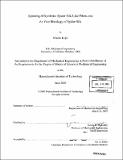Spinning of synthetic spider silk-like fibers and ex vivo rheology of spider silk
Author(s)
Kojić, Nikola, 1978-
DownloadFull printable version (13.06Mb)
Other Contributors
Massachusetts Institute of Technology. Dept. of Mechanical Engineering.
Advisor
Gareth H. McKinley.
Terms of use
Metadata
Show full item recordAbstract
Spider silk has been hailed as nature's super-fiber based on its mechanical properties. A synthetic analog would have numerous applications, from the textile industry to suspension cables for bridges. This thesis discusses attempts to spin a synthetic spider silk-like material (a concentrated polyurethane solution) into fibers whose diameter is approximately that of spider silk (- 1 micron). In particular, the influence of spinning conditions on fiber mechanical properties was studied. By using numerical methods to model mass transfer experiments much insight was gained on how solvent removal during elongational flow (while the fiber is on the spin line) affects mechanical properties. In order to determine solvent evaporation from the fiber during spinning, the dependence of the solvent diffusion coefficient on solvent concentration had to be obtained. This dependence was found by performing a simple experiment where a small amount of the solution was placed in a pan, which was then put in a controlled environment. The mass loss due to solvent evaporation was recorded and then modeled by using a finite element software package. A numerical algorithm was developed to determine the dependence of the solvent diffusion coefficient (through the solution) on solvent concentration that would match the experimentally obtained mass loss curve. It was assumed that in the pan diffusion was a one-dimensional process. Applying similar principles to a different geometry (i.e. cylindrical), and using the determined diffusion coefficient, the solvent removal from the fiber during the spinning process was modeled. Specifically, two cases were examined (a thick and thin fiber) that showed how more solvent was removed for the thinner fiber having a longer spin line. Thus, better mechanical properties were expected for the thinner fiber since more solvent was removed during elongational flow, enhancing polymer chain interactions and alignment. Mechanical tests showed that the thinner fiber had five fold better mechanical properties than the thicker fiber, indicating the importance of solvent removal. The use of two micro-rheometric devices (a microrheometer and a capillary break-up rheometer) enabled ex vivo rheology measurements of a spider's spinning solution (dope). Each apparatus was designed to accommodate the small quantities (-1 microliter) available from the spider's major ampullate gland. A shear thinning behavior of the dope was observed using the microrheometer. The capillary break-up rheometer was used for extensional rheology. The rheological findings indicate potential mechanisms that could be employed by the spider to push an extremely viscous solution through a narrow spinning canal. The results of this thesis could be used in future efforts to elucidate the spider's spinning process and to make a superior synthetic, application specific, spider silk analog.
Description
Thesis (S.M.)--Massachusetts Institute of Technology, Dept. of Mechanical Engineering, 2003. Includes bibliographical references.
Date issued
2003Department
Massachusetts Institute of Technology. Department of Mechanical EngineeringPublisher
Massachusetts Institute of Technology
Keywords
Mechanical Engineering.